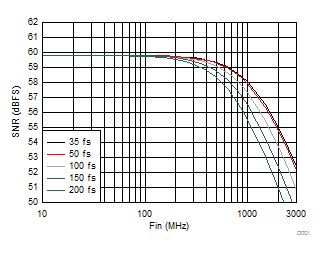SLAS669E September 2010 – may 2020 ADS5400-SP
PRODUCTION DATA.
- 1 Features
- 2 Applications
- 3 Description
- 4 Revision History
- 5 Pin Configuration and Functions
- 6 Specifications
-
7 Detailed Description
- 7.1 Overview
- 7.2 Functional Block Diagram
- 7.3 Feature Description
- 7.4 Device Functional Modes
- 7.5 Programming
- 7.6 Serial Register Map
- 8 Application and Implementation
- 9 Power Supply Recommendations
- 10Layout
- 11Device and Documentation Support
- 12Mechanical, Packaging, and Orderable Information
Package Options
Mechanical Data (Package|Pins)
- HFS|100
Thermal pad, mechanical data (Package|Pins)
Orderable Information
8.2.3 Application Curve
Figure 40 shows the SNR of the ADC as a function of clock jitter and input frequency for the device. This plot of curves take into account the aperture jitter of the ADC, the number of bits of resolution, and the thermal noise estimation so that Figure 40 may be used to predict SNR for a given input frequency and external clock jitter. Figure 40 then may be used to set the jitter requirement for the clocking solution for a given input bandwidth and given design goal for SNR.
 Figure 40. SNR vs Input Frequency and External Clock Jitter
Figure 40. SNR vs Input Frequency and External Clock Jitter